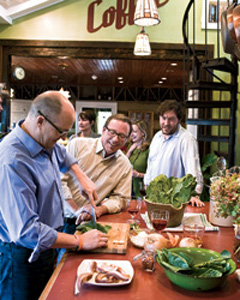Written by John Currence. Brought to you by FoodandWine.com.
Mississippi chef John Currence was once infamous for his profligate eating habits. But now he makes low-fat versions of the Southern dishes he craves that are delicious enough to serve guests at a dinner party. Here, he tells how.
When pancreatitis hits, it’s like a phantom freight train, hard and with no warning. Trust me on this. I was a 44-year-old, pork-eating, whiskey-swilling chef in Oxford, Mississippi. I thought I was indestructible, but that belief came crashing down last summer, when I spent three weeks in a hospital bed, near death, as penance for my poor lifestyle.
As much as I knew about food, it turns out I didn’t know very much about nutrition. I was a grab-and-eat survivalist in the kitchens of my three restaurants, snatching anything that was close at hand: a big piece of roast chicken skin, a slice or two of bacon.
While I was still in the hospital, I also began imagining my first meal at home. I realized I could create a welcome-home menu from several dishes I’d lightened in my head. I’d even create a nectarine-and-plum crisp using whole-wheat flour in the subtly sweet streusel topping. When I finally got to have that dinner, with my wife, Bess, and several close friends, it couldn’t have been better or more satisfying. It wasn’t my grandmother’s fried chicken, but I know my grandmother would have been happy to eat it, anyway.
In the hospital, I started dreaming about fried chicken and fruit crisps and crumbles, which were now completely off limits. My daily intake of fat would have to be roughly equivalent to a Reese’s Peanut Butter Cup (not that I could have eaten one, because sugar was almost entirely forbidden). I knew that my restaurant dishes would probably end up looking a little different, too. I was OK with the changes—my customers had been asking for healthier food, anyway—but I wanted to do it in a way that wasn’t too predictable and stayed true to my family’s deep-South roots.
I scoured the Internet for healthy cookbooks and fell in love with Heidi Swanson’s blog, 101 Cookbooks (101cookbooks.com), which has a great balance of authenticity and nutritional savvy. I came up with some strategies: Instead of rich sauces, I’d use seasoned vegetable purees and vinaigrettes. Rather than sautéing spice-crusted shrimp in butter to serve with buttery grits and a butter sauce, I would roast the shellfish and accompany it with quinoa and a vibrant herb pistou. For the fried chicken I’d been fantasizing about, I’d brine skinless breasts, then coat them with well-spiced flour before pan-roasting; then, I’d use a little canola oil to prepare a caramelized-onion gravy. I could even make crumbly corn bread using low-fat buttermilk and fat-free sour cream.
While I was still in the hospital, I also began imagining my first meal at home. I realized I could create a welcome-home menu from several dishes I’d lightened in my head. I’d even create a nectarine-and-plum crisp using whole-wheat flour in the subtly sweet streusel topping. When I finally got to have that dinner, with my wife, Bess, and several close friends, it couldn’t have been better or more satisfying. It wasn’t my grandmother’s fried chicken, but I know my grandmother would have been happy to eat it, anyway.
John Currence is the chef and owner of City Grocery, Bouré and the aptly named Big Bad Breakfast in Oxford, Mississippi.
 See more about health-conscious foodies from FoodandWine.com:
See more about health-conscious foodies from FoodandWine.com:
Joel Robuchon: From Haute to Healthy
Eat Like a Food Critic and Stay Slim
Photo © Peter Frank Edwards

